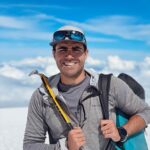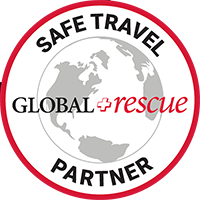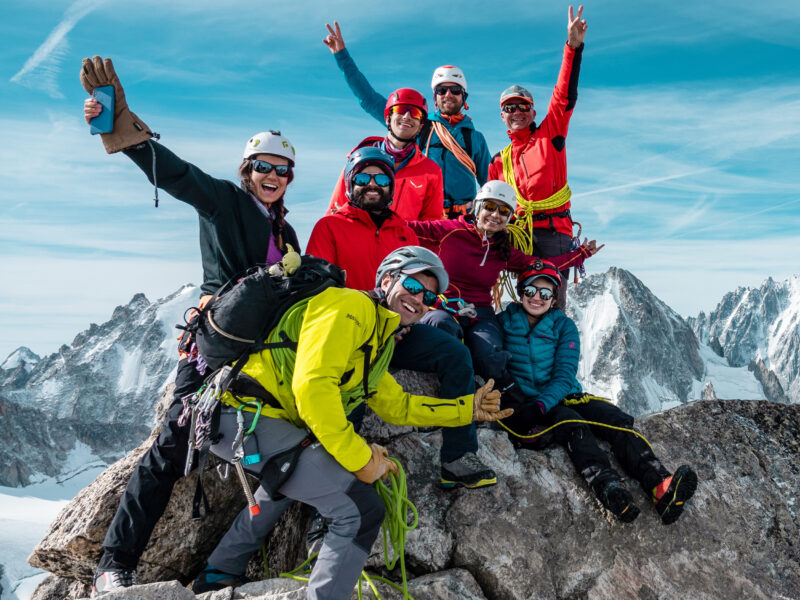BY Rami Rasamny | March 11 2025
Hari Budha Magar: The Untold Aconcagua Story
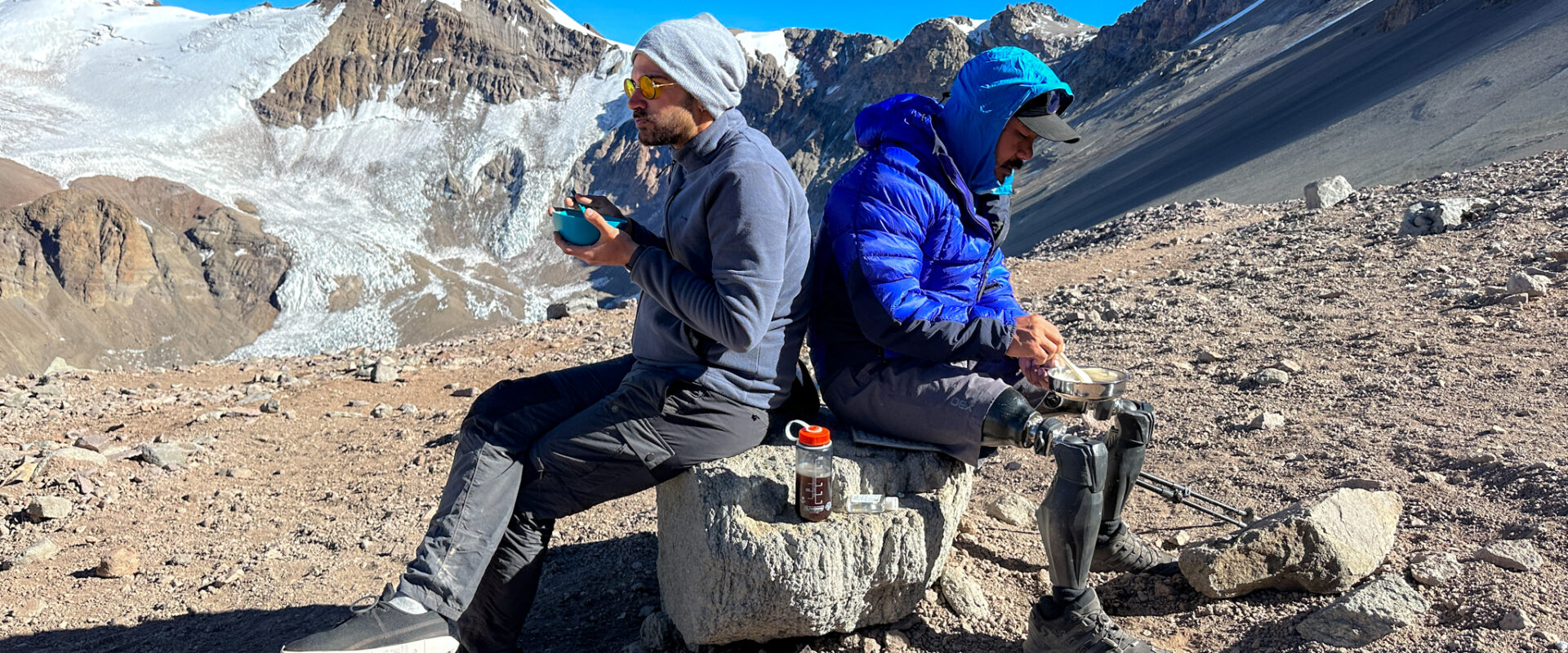
We were in the Tête Rousse hut together in 2019. That was the first time I had ever heard of him. I was climbing with a Nepali friend named Shashank Agrawal. He pointed Hari out to me and told me that this was the guy who was suing the Nepali government for discriminating against him and not giving him a permit to climb Everest. That was, incidentally, also the evening that I proposed to my wife.
Life Happens Outdoors took on the gargantuan mission of “empowering humanity to answer the call to adventure.” Even before this expedition, LHO had already embarked on an ambitious program that includes mountaineering objectives with people who have challenges such as cerebral palsy, visual impairment, or other forms of amputations. So when the opportunity with ABLE on Kilimanjaro and then Hari on Aconcagua presented themselves, we didn’t hesitate. Our commitment to making adventure more inclusive and accessible meant that these challenges aligned perfectly with our vision.
Hari and I have been friends for a few years now. I was drawn to his story from the first time I heard it. His journey of resilience overcoming obstacles that most people wouldn’t even dare face was one that resonated deeply. By then, I had already embarked on my own journey with ABLE.KSA and Life Happens Outdoors, working to make adventure and mountain objectives more accessible to people with disabilities. My first project had been on Kilimanjaro with Raneen Faraidy, who has cerebral palsy, and Frederik Sfeir, who has retinitis pigmentosa. So when the opportunity to support Hari came up, it was a no brainer.
Although LHO has been running Aconcagua for half a decade, this was my first time leading an expedition there. Hari specifically wanted me to personally manage the expedition, which was an immense honour. I have extensive experience in the Andes, but Aconcagua had always been managed by other expedition leaders on behalf of LHO. This time, it was my turn.
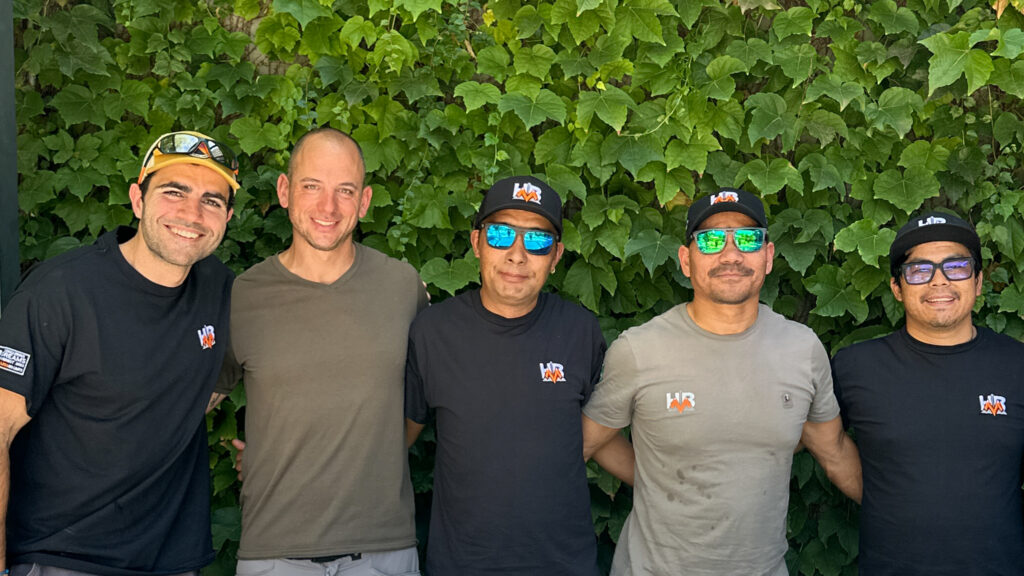
Hari and I hit it off in large part because of our similar backgrounds. We are both immigrants to the UK, though I am second generation. I have also spent a tremendous amount of time in Nepal and not only understand but have adopted many nuances of Nepali culture into my life. This deep connection was one of the reasons we bonded so quickly. In Nepal, it is a sign of respect to refer to an elder brother or someone of senior status as “Dai.” I call Hari “Dai” because of his seniority as an accomplished adventurer who commands my respect.
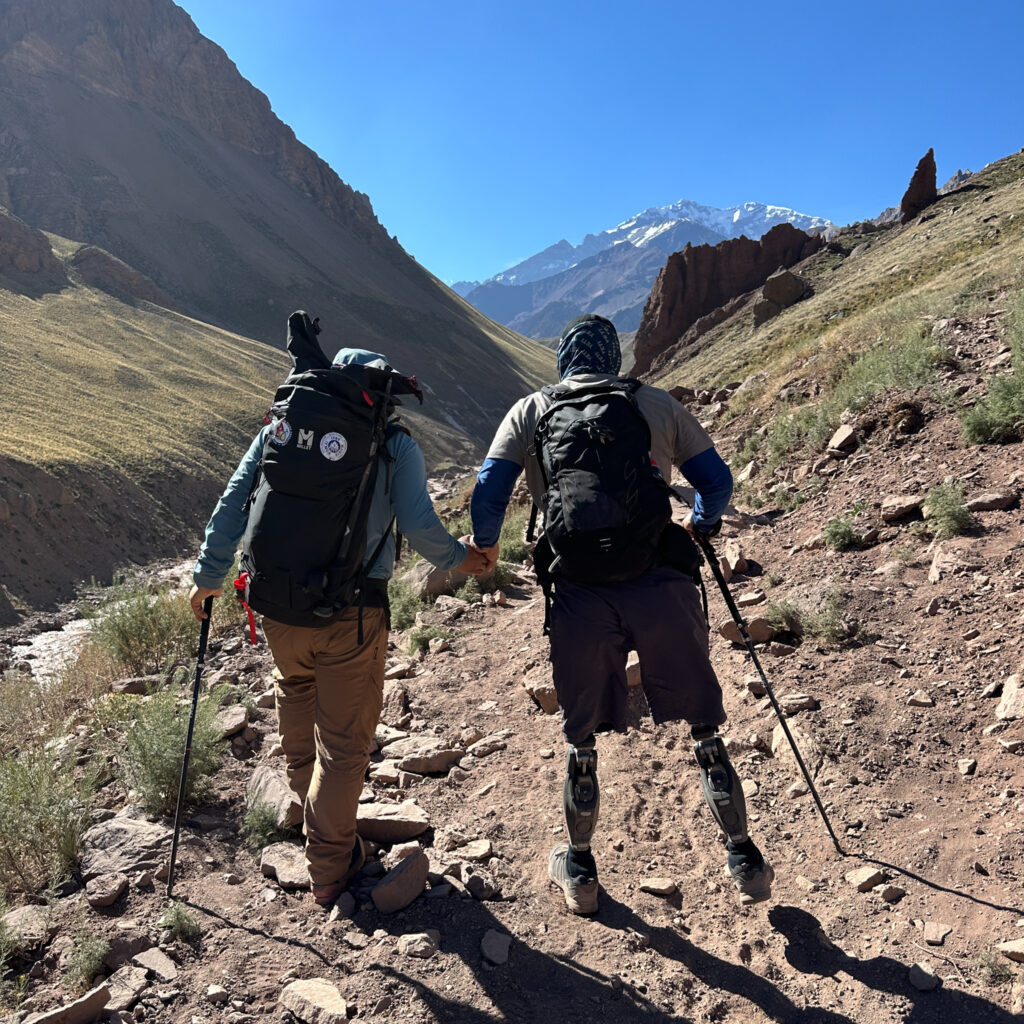
The first challenge we faced wasn’t even on the mountain. It was in an embassy. Frederik Sfeir’s visa from the Paris consulate was delayed, forcing him and Khalil Chehab, Fred’s longtime friend, a founder of ABLE, an investor in Life Happens Outdoors, and a longtime LHO climber to miss the start of the expedition and arrive four days late. Meanwhile, IFMGA Guide Abiral Rai and 9 time Everest summiteer Mingma Phortse Sherpa faced their own logistical nightmare when their bags were mistakenly checked into Brazil instead of Argentina while boarding in Kathmandu. This caused significant issues in Istanbul, where it became clear that they didn’t have visas for Brazil and therefore couldn’t retrieve their bags. This is something a lot of Westerners don’t understand it adds layers of stress and complications that the average person in the West just doesn’t experience. Meanwhile, the rest of the team was delayed by a landslide, which pushed the entire expedition back by one day. The splitting of the team, each facing their own unique challenges, made logistics a major challenge for me. It necessitated that I descend from Plaza de Mulas back to Confluencia to receive Fred and Khalil, meaning I had to do the longest day of the entire expedition three times in 24 hours very early on in the climb. This amounted to a total of 54 kilometers covered within a single day an immense physical and logistical challenge that tested my endurance right from the start of the expedition.
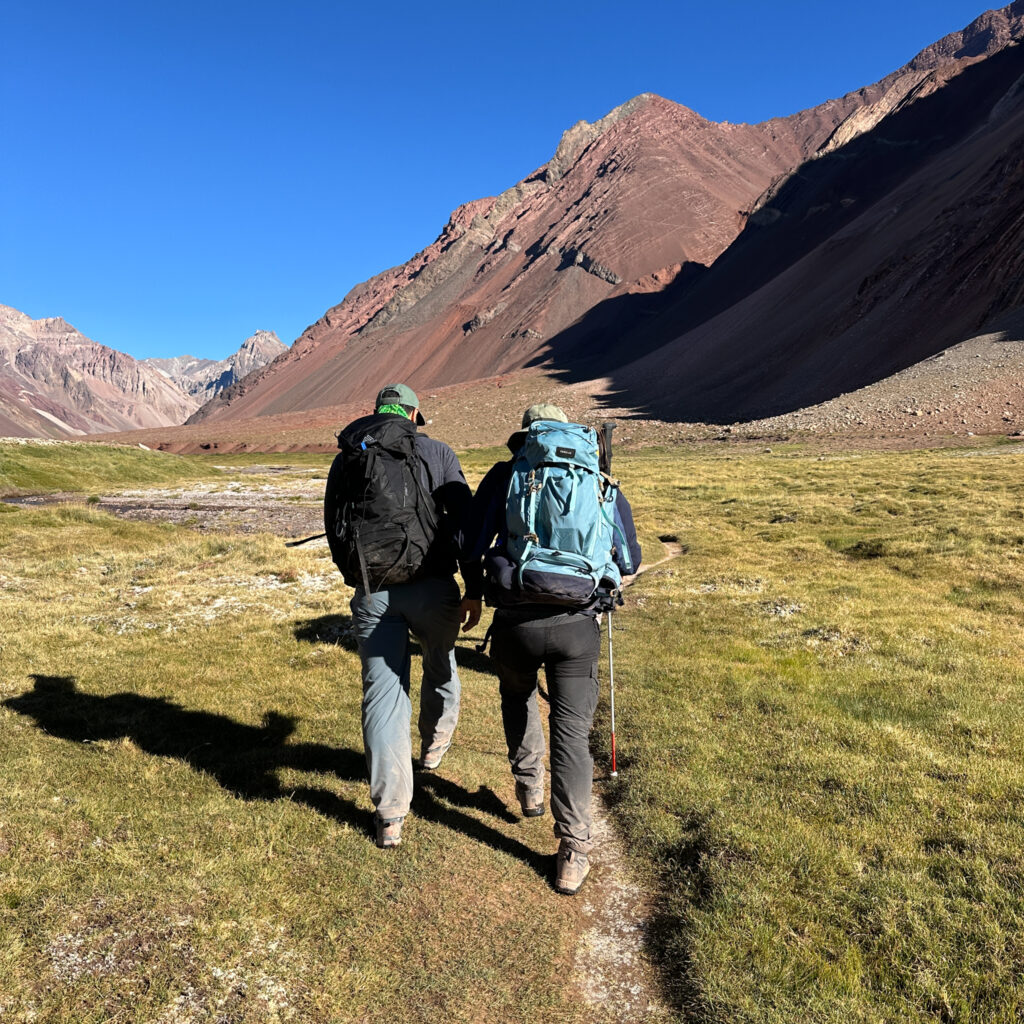
Then, as we finally got moving, the landslide meant that instead of spending a night at the gate before starting the trek, we had to go straight into the first trek immediately after the long car journey from Mendoza. This was especially tough for Hari, whose prosthetic legs meant that proper rest was crucial.
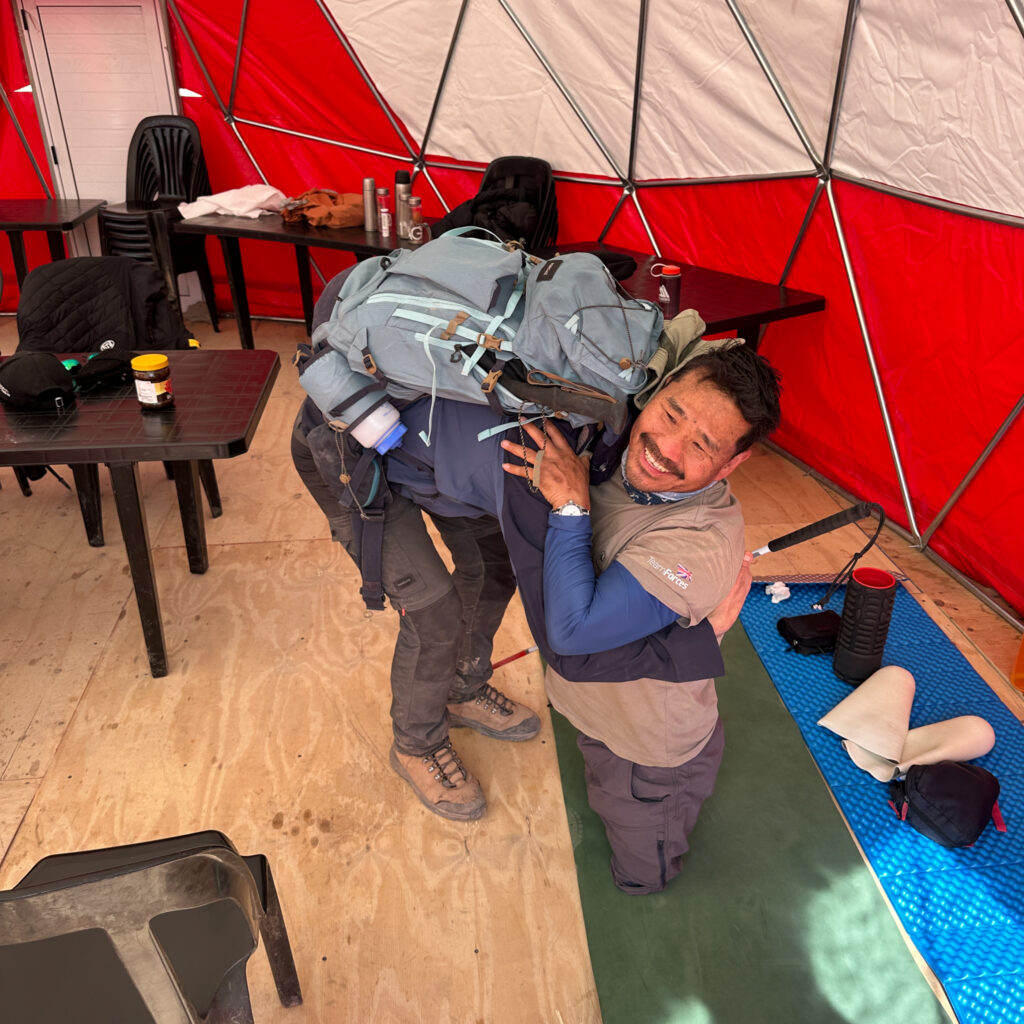
Early on, we had identified February 22 as the best summit window. This meant staying in Plaza de Mulas longer than was originally envisioned for Hari because we didn’t want him ascending and descending as part of the regular acclimatization procedure on Aconcagua. We prioritized rest. Hari summed it up perfectly when he said that “Aconcagua requires patience because there is a lot of waiting around for weather and ideal times to move.” That waiting around can often be the most challenging aspect of the entire expedition.
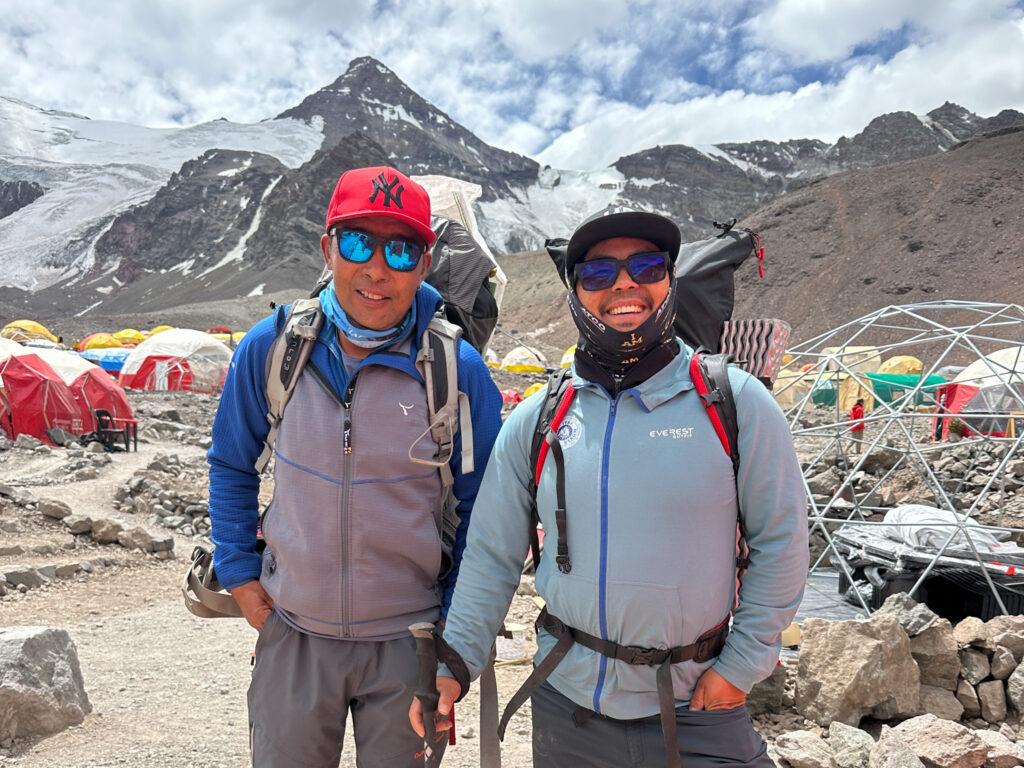
As we got closer, it became clear that the weather on that date was going to be ideal. But we had three logistical issues to solve. First, the main tent at Plaza Canada (Camp 1) had been blown away by high winds the day before we planned to climb, meaning we couldn’t spend two nights there. We adapted, pushing through with just one night instead. Second, the ice spikes we usually use to melt water had dried up, and the nearby streams were filled with clay. We had just enough water for the night and the next climb, but no margin for error. I made the call to have 12 extra liters sent up from Base Camp.
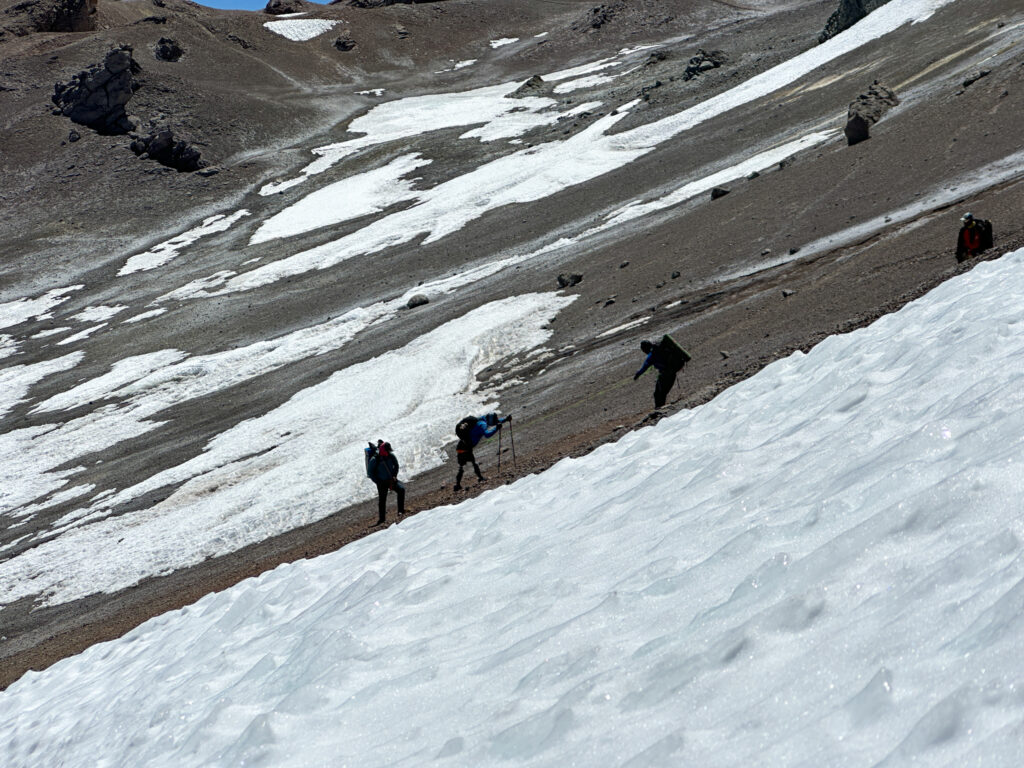
Third, as we ascended to Camp 2, we unexpectedly found a faster and more efficient way to move Hari on the rope system, getting us to camp within normal time. We tied in with our harnesses as if in a technical rope party scenario. Instead of pulling him up, we would take the slack in the rope just enough so that he felt secure stopping on his legs, knowing he wouldn’t fall backward. From that point onwards, the team dedicated to him would take turns leading on the rope and taking the slack, ensuring a continuous system of support and stability throughout the ascent.
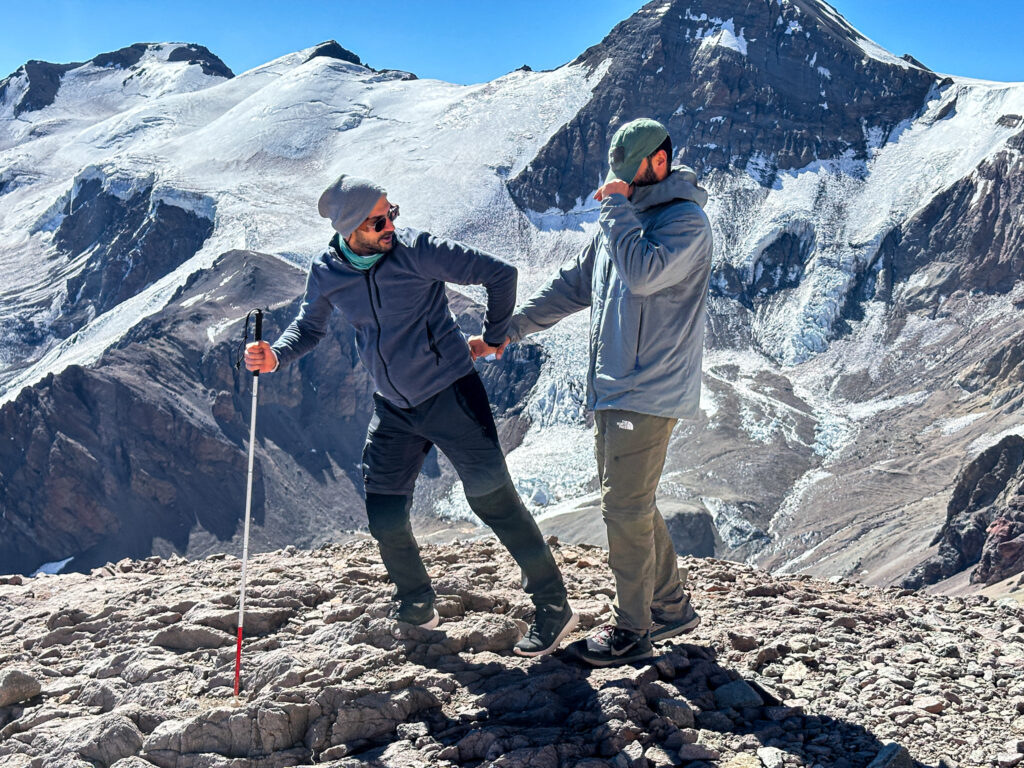
Camp 3 was a major turning point. For the first time, Hari’s team arrived before Fred’s team, signalling that he was moving at a much better pace than expected. This changed our entire summit strategy. Instead of starting extremely early in harsh winds and cold, we opted for a 3 a.m. start, just one hour earlier than usual.

On summit night, Fred struggled with holding onto the backpack strap due to the size of his mittens. Fred usually feels confident when he can physically feel his fingers and hands clasp onto someone or something. The thick mitts made that impossible, depriving him of the sensation of grip that he relied on for security. We put a rope loop for him to place his full hand inside, but this only made him nervous, and he wasted a lot of energy just trying to feel like he could hold onto something. Knowing that taking off his gloves would mean inevitable frostbite, he had to make do with what was possible in the moment. To solve this, we tied a short rope with a loop so he could insert his entire arm into it. But he wasn’t comfortable with this adaptation, and it led to a tremendous expenditure of energy. We can relitigate the reasons for the loss of energy by the time we got to Plaza Independencia, but this was clearly one of the contributing factors to his exhaustion.
At Plaza Independencia, 6400m, Fred fell to the ground in a dramatic moment of relief and exhaustion. He was responsive and showed normal safe signs of general fatigue, but it was clear that this was the limit. After a short discussion with Bruno, we decided the time had come to turn around. Fred took it like a true adventurer. He knew and trusted us. He then insisted that Khalil join me and take his RP Warrior flag to the summit.

Fred sums up those moments from his perspective: “When we took the decision, I was very much lost because some of me said I can keep going and part of me said that I should go back. And when Khalil told me that he was coming back with me, I got mad and sad because I didn’t want him to turn around and go back with me since we already made it that far and I knew that Khalil is a beast and that could make it to the summit. He was being very stubborn and really wanted to go back with me telling me that there is no reason to keep going. But actually the reason why he needed to keep going is because I was turning back so at least one of us can make it to the summit.” Bruno and I agreed that I would take Khalil to Hari’s team, who were not very far ahead, just midway through the traverse. So we got moving.
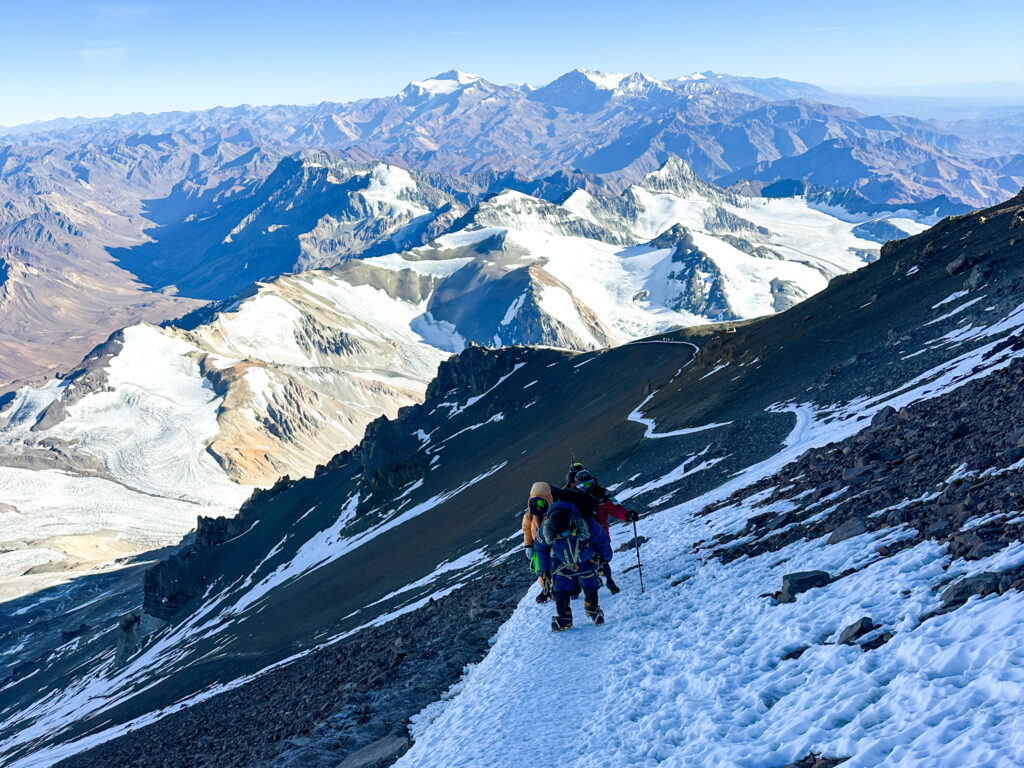
Catching up with Hari took about 20 minutes. Almost immediately, the game shifted from one in which I was managing multiple teams to having my full focus on this one team. There was no time to think about how things could have been done differently for the others. I had to focus on where I was and the team that I now had. Gustavo was moving efficiently with the team, and within a short time, we were at the cave at 6600 meters. The cave is the last checkpoint before the summit. Hari was still on his long legs at this point, but we quickly changed to the short legs that had been customized with crampons. The short legs gave him maximum friction, and he used ice axes with his hands as he ascended on all fours. This method was much slower but significantly safer.
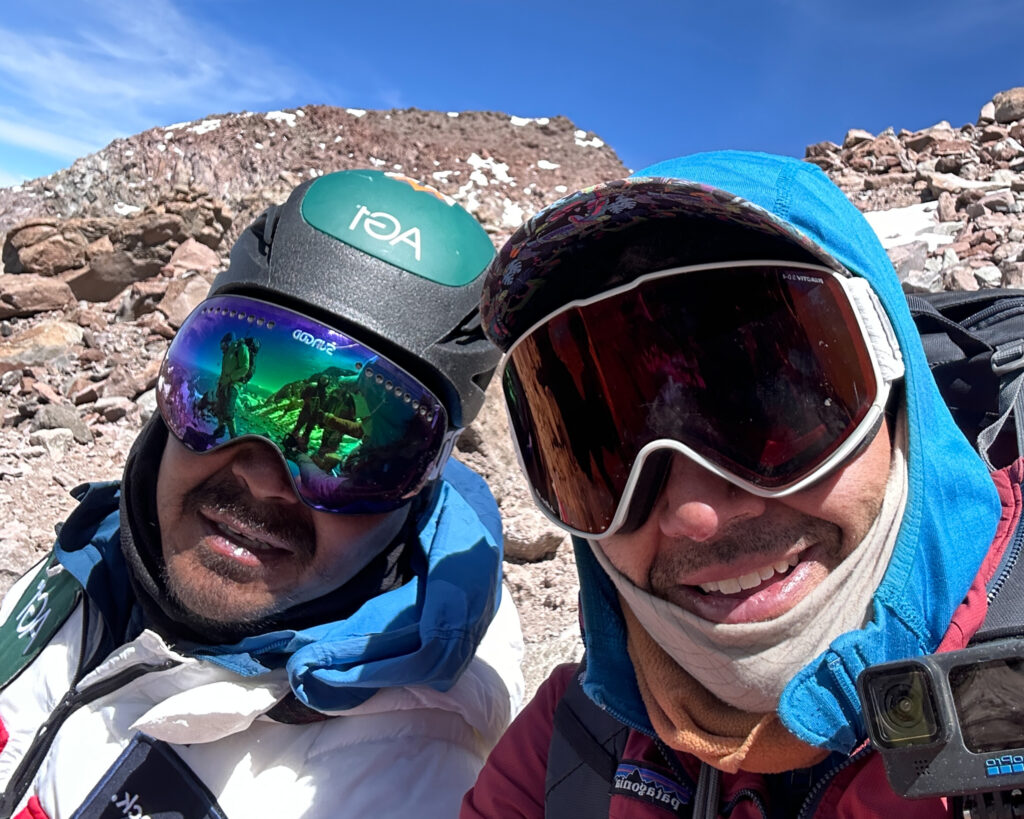
As we neared the summit, we began to pass climbers on their way down. Surprisingly, we weren’t that far behind the fastest teams on the mountain that day. There wasn’t a single person who didn’t stop, applaud, and fist bump Hari. It kind of felt like the final stages of a marathon suddenly the fatigue and aches subsided. All the thoughts of how far or how long just evaporated, and renewed energy filled the air. That was my cue to leave the team behind and make my way to the summit to prepare the cameras to receive a historic moment in mountaineering history. I took Khalil with me as my assistant, almost forgetting that this was a big moment for him too.
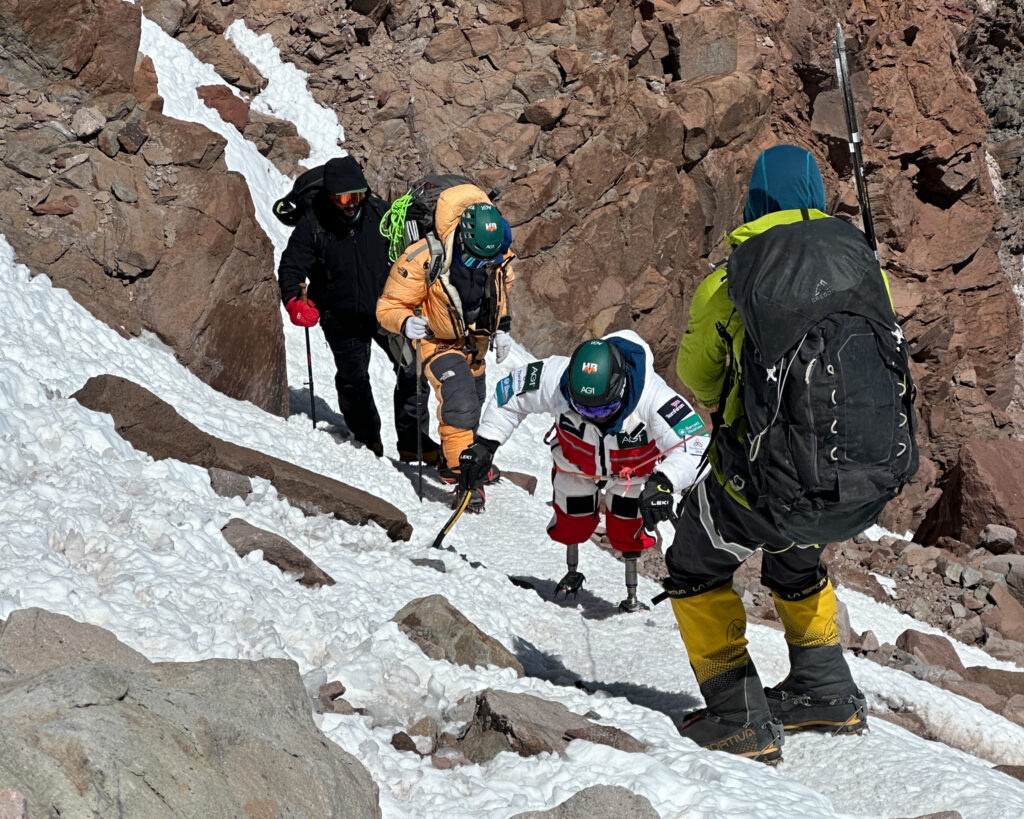
After about 15 minutes setting up camera angles on the summit, I saw Gustavo and, behind him, the entire team. You can say a lot about what happens to a person on the top. It’s a rollercoaster of emotions relief, joy, sadness. You see where you are, but you also see what got you there. The pain. The grief. The hardship not just on the mountain. That’s what the summit ultimately is. It’s the furthest point you reach on your journey. But every single step you take on the way to the top is what makes it what it is. Otherwise, it’s just a pile of rocks. It’s your entire life. The girl that rejected you in high school. The bad grades. The good grades. Being picked first or last in sports. Your relationship with your parents. The good, the bad, and the ugly. It’s all there. And you can only imagine, with Hari’s life story, what that means.

As we neared the summit, Khalil walked alongside Hari, carrying Fred’s RP Warrior flag as a tribute to his perseverance and the collective effort it took to get here. The final steps were emotional. With each movement, Hari pushed beyond what most would consider possible. When we finally reached the top, the team erupted in celebration. The wind howled, the sky stretched endlessly around us, and for a moment, nothing else existed except the achievement we had just witnessed.

Hari was now at the top. He was there. I was snapping his pictures. His support climbers were hugging him, laughing with him, taking out flags for sponsors. But all this time, Gustavo and I were keeping our eye on the time. Time was getting away from us, and 45 minutes later we knew it was time to go and that the real struggle had only just begun.
Shortly after leaving the summit, we could feel the energy in the group start to drop. Sections that would normally take 10 minutes were now taking 20. Every 10 steps would necessitate a few minutes of rest. Hari has it tough on the way down. He goes down backwards on his short legs, which means double the effort for half the distance and without being able to see where he is going, relying only on our direction. Reaching the cave took about half the time it took to ascend from there to the summit, but after a long rest there, the traverse in the direction of Plaza Independencia first took as long as the ascent and then quickly started to exceed the time. This was when Gustavo and I decided to activate our Camp 4 plan.
I departed the group with Khalil to set up Camp 4 for the team at 6500 meters because it became impossible for them to get back to Camp 3 as time was getting away from us. Halfway to Camp 4, we came across Luis and his guide, who was administering Dexamethasone to him because he was exhibiting signs of AMS. We offered help and were assured that things were under control. We climbed over the col and descended to Camp 4, where we set up the tent and positioned it protected from the wind. Gustavo had already communicated with Camp 3 and informed them of the activated plan, which meant that Bruno was on his way up with food and water.
I waited with Khalil at Camp 4 until we had visual confirmation that Gustavo, Hari, and the team were doing well before descending to Camp 3. We didn’t see Bruno on the way up because he had taken a different route, but we were reassured at Camp 3 that he had already reached Camp 4 by the time we had arrived. We also passed Luis again on the way down, who was lying on his back just moments from the camp. We exchanged a few words of encouragement and then entered the camp after 16 hours exposed. Fred was there to greet us with his usual positivity. The hug lasted longer than would be socially acceptable in any other environment.

The next morning, Hari made his way down with the rest of the team. It took them about an hour and a half, which was fantastic time. They were in good spirits and good health, which was great considering nights above 6500 can be brutal. We put together a plan to descend to Camp 2 and then arranged a helicopter to lift Hari from there. We wanted to avoid the long descent, which we knew would be a big challenge especially because he started from Camp 4 that morning and our aim was to descend to Base Camp, where the team could properly recover from the exposure to high altitude.
We packed up and headed out. Getting to Camp 2 was a breeze. The drop in altitude, coupled with good weather and a night’s rest, gave everyone a big boost. Once we got to Camp 2, we were thrown another curveball. The heli we booked wouldn’t fly until 7 p.m. It was still 11 a.m. To make things more challenging, the park rangers and first response services had vacated the premises as it was coming close to the end of the season. The helicopter excuse was that it was too warm to take off where the heli was, and they needed the evening hours to have good temperatures. The issue we faced was that if there was any hiccup in the heli service and they couldn’t fly, we would be exposed with no Camp 2 services available.
I couldn’t risk it, and after an hour of telephone calls and trying to find a way out that wouldn’t have Hari back on his feet, I finally had to break the news that we would be heading down to Base Camp on our feet. He took it like a champ almost immediately ready to go and before we knew it, we were on our way down. He benefitted from the scree that makes it easy for him to descend in a straight line, still on the short legs. The biggest challenge at this point was the dust. His face is literally inches from the ground when he descends, and in the heat of the afternoon, there is no ice to keep the ground hard. He was literally sliding down in a pile of dust. But, at the same time, he was keeping up with Fred’s team.
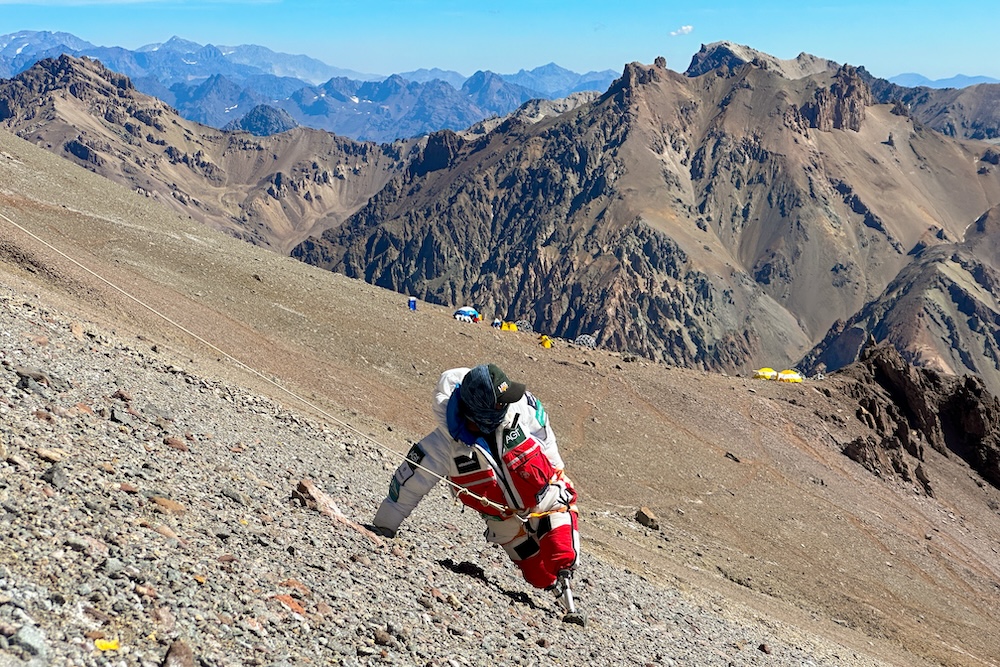
As fate would have it, we were back at Base Camp in time for the Sunday BBQ, which meant all the climbers were out and about. When Hari appeared at Base Camp, everyone stopped what they were doing, and applause ensued. Like on the summit, everyone wanted to be a part of this, even just to clap. Walking into Base Camp with Hari was the single greatest moment in my mountaineering life. Yes, this was for Hari, but really, this was for all of us. We each had a step on his summit, and that was incredibly powerful to everyone there. The altitude, the effort, and the emotional weight of the journey had taken their toll, and we needed to rest before continuing down.
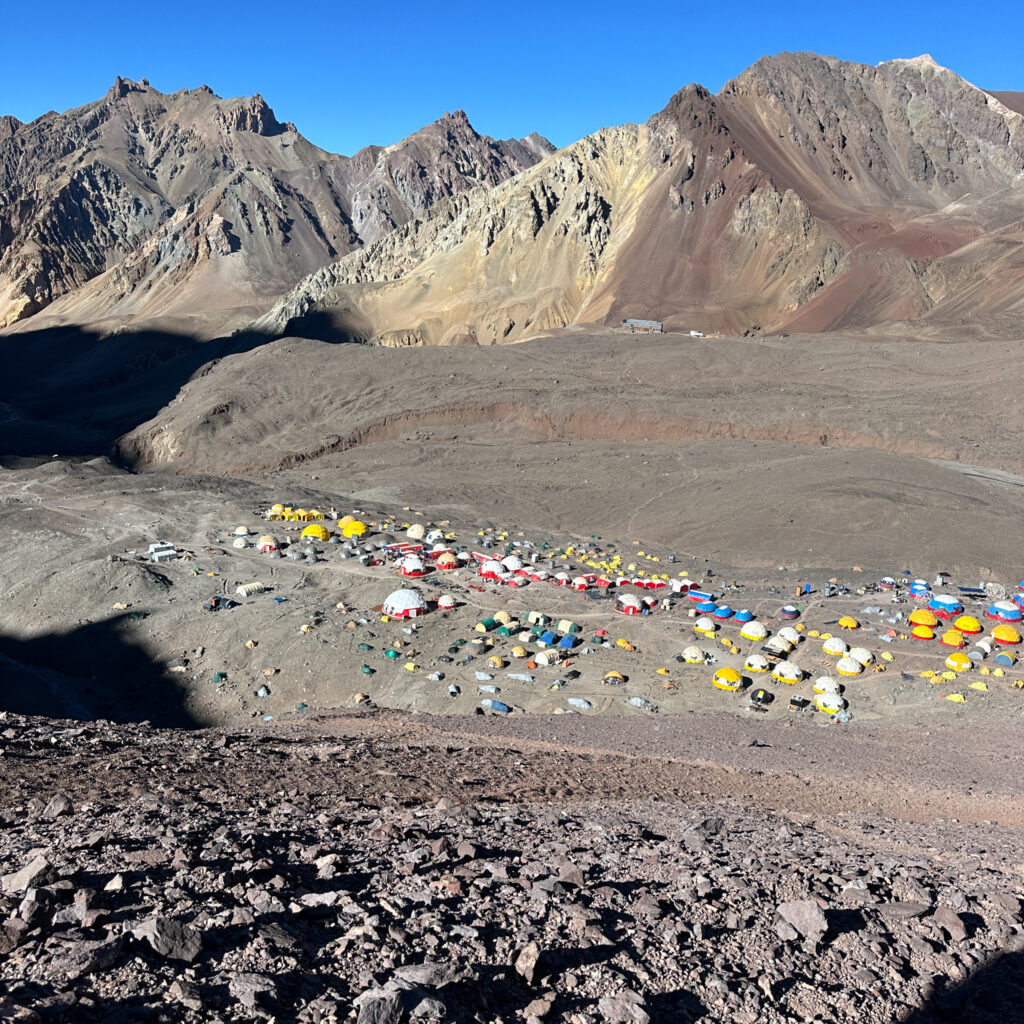
On reflection, those days spent at base camp paid off. “The wind is famously the challenge but we’ve been very lucky and strategic in how and when we’ve chosen to move making our exposure to wind more limited.” Those are Hari’s words. Yes, he’d already been on the summit of Everest but here’s what he had to say about Aconcagua: “This was one of the most difficult mountain I’ve climbed in its own way – it was physically and mentally exhausting as I climb three times slower than an able-bodied mountaineer.” In the moments, he put on a brave face. Always smiling. Always ready to stay positive like he did at the cave. But, the truth is inescapable. Here is a double over the knee amputee climbing in an environment that only the fringe few of abled bodied people will ever commit to.
A special thanks to Elie Abi Akar, LHO Base Camp Chief; Gino Traboulsi, Deputy Chief of LHO Base Camp; Bader Al Sayyed Ahmed, Chief of LHO Field Operations; Hazem El Shamy, Chief of LHO Marketing; Niraj Shrestha, CEO of Rural Heritage Nepal; Hilda Schilardi, Personal Adventure Advisor at Inka Expediciones; and Sofia, Sol, Victoria, Rafael, and the entire Plaza de Mulas team, along with the incredible team of porters and gauchos. Of course, the final thanks is to my wife Ghida Arnaout who got much more than she signed up for when she married me and who I am infinitely grateful to for always supporting me no matter what.
About The Author
Rami Rasamny is the founder of Life Happens Outdoors, a premium adventure travel community dedicated to transforming lives through curated outdoor experiences. A mountaineer and entrepreneur, Rami has led teams on some of the world’s most challenging peaks, from the Alps to the Himalayas. His mission is to make adventure accessible, transformative, and safe for all who seek to push their limits and Come Back Different.
About Life Happens Outdoors
At Life Happens Outdoors, we believe in the power of nature to transform lives. As proud members of the Adventure Travel Trade Association (ATTA) and the World Travel & Tourism Council (WTTC), our team of certified guides and outdoor professionals is committed to the highest standards of safety, sustainability, and excellence.
Discover more about our story and mission on our Meet LHO page, or explore our curated adventures such as the Tour du Mont Blanc Trek, the Climb of Kilimanjaro, and Chasing the Northern Lights.








